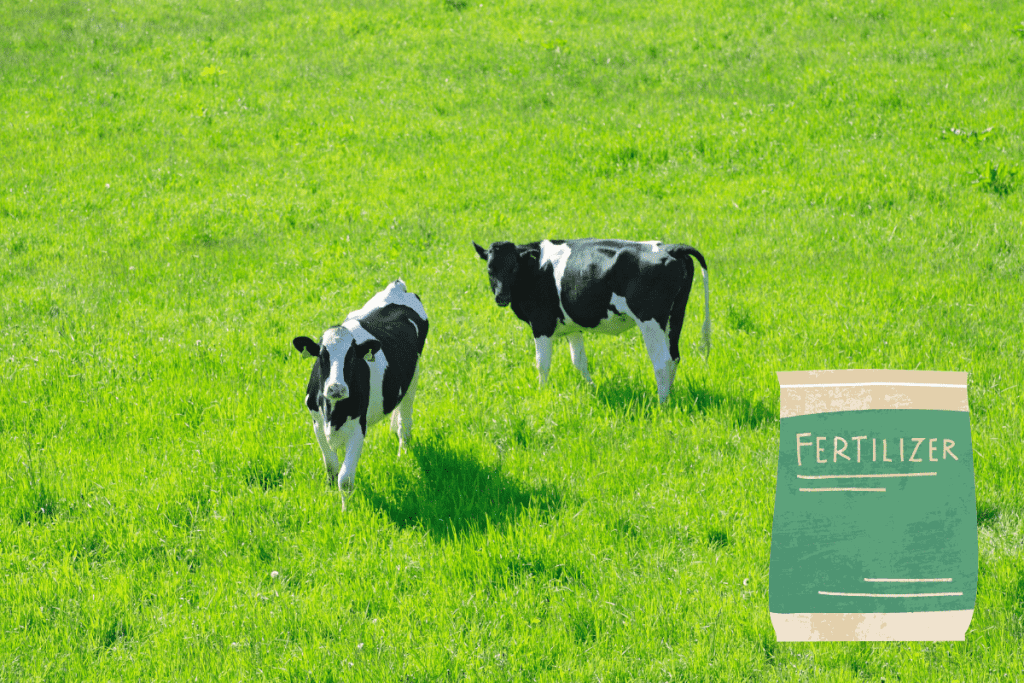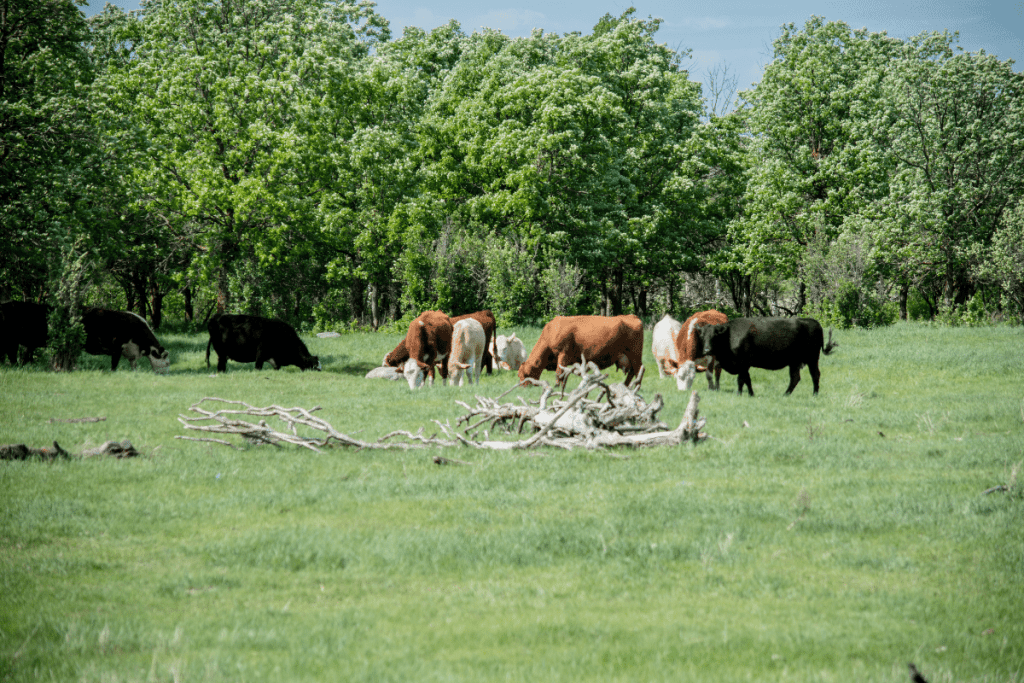A lush pasture for your cattle to graze in is important for their health.
Without enough forage and grass in the pasture, your cattle will have nothing to eat.
Cattle farming in the hot summer months and areas of drought is challenging.
Careful planning and preparation are needed to ensure the pasture has plenty of growth.
Many farmers give their pasture a boost with fertilizers.
But is it okay to spread fertilizer on the pasture where your cattle graze?
It is generally okay to spread fertilizer on the pasture as you choose the right products and keep the safety of your cattle in mind. Timing is critical to ensure your field stays lush beyond the growing season.
Cattle are very sensitive to nitrates and will be poisoned if they ingest too much urea or nitrogen fertilizer.
There are several ways to fertilize your pasture without creating a hazardous situation for your cattle.
Read on to learn how to fertilize your pasture while keeping your cattle safe and tips for maintaining a healthy pasture.

Table of Contents
ToggleTypes of Fertilizers Used in Pastures
Commercial fertilizers will produce quicker results but are also very dangerous to your cattle if they are not used properly.
Inorganic fertilizer application must be done carefully to avoid poisoning your animals.
Granular fertilizers take longer to reach the soil than liquid fertilizers, and the cattle may eat the granules.
Liquid fertilizers may run off into nearby surface waters if they are washed away by rain.
Always have alternative access to water for your cattle in case rural water sources become contaminated.
Many farmers prefer to use organic fertilizers, such as poultry litter or animal manure.
Poultry litter is also sometimes alternated with a commercial fertilizer source.
Annual forage yields in pastures treated with poultry litter are like fields treated with commercial fertilizer.
But only if the poultry litter has the same nitrogen fertilizer rate.
Poultry litter consists of chicken feces and urine mixed with bedding materials.
The poultry litter may also contain small amounts of feathers and spilled poultry feed.
Poultry litter is a rich source of nitrogen and phosphorus.
It also contains some potassium, calcium, zinc, and sulfur.
The soil uses almost all the potassium in poultry litter when applied during the growing season.
Clover pastures fertilized by poultry litter have higher calcium, phosphorus, and potassium content.
This is especially true when compared to fields treated with commercial fertilizer.
The results of using poultry litter vary depending on the type of forage and soil quality.
These organic fertilizers are also hazardous to your cattle if they are not applied correctly.
High sulfur forages from poultry litter may cause a copper deficiency in cattle.
Adding a copper supplement to the herd’s diet is recommended.
In areas with a lot of rain or sandy soils, the sulfur content of forage may be lower as the water moves the nutrients through the ground more quickly.
Studies have also shown lower magnesium contents in forage fertilized with poultry litter.
This may be corrected by adding dolomitic lime to the soil or giving your cattle a magnesium supplement.
Causes and Symptoms of Fertilizer Poisoning in Cattle
Nitrate poisoning is one of the most common reasons for illness and death in cattle.
When cows ingest the nitrate form of nitrogen, it is converted into nitrite and ammonia in the rumen.
A cow does not have to directly ingest a fertilizer to become poisoned because nitrates naturally accumulate in plants.
Excessive poultry litter or animal manure is the most common cause of nitrate build-up in forage and grasses.
Other causes of nitrate build-up in plants include:
- Drought
- Excessive heat
- Low humidity
- Frost
- Lack of sunlight
- Herbicides like 2,4-D*
- Soil imbalance
*Further Reading: How 2,4-D affects cattle
These conditions halt plant growth and cause nitrates to accumulate in the stems of young plants.
Nitrate build-up will occur in plants exposed to harsh conditions even without an excess of nitrogen fertilizer application.
Ammonium nitrate fertilizer is found in commercial products and will also cause a nitrate build-up in plants.
The most common signs of nitrate poisoning in cattle include:
- Difficulty breathing
- Rapid breathing
- Weakness
- Muscle tremors
- Diarrhea
- Frequent urination
- Decreased milk production
Regularly check on your cattle.
If you notice these signs, you must seek veterinary treatment immediately and remove your animals from the pasture.
Nitrate poisoning in cattle may cause death within 30 minutes to four hours after noticeable symptoms appear.
Related: Can you eat a cow that died of natural causes?
Treatment for nitrate poisoning in cattle involves an injection of a 1% solution of methylene blue into the bloodstream.
The injection may need to be repeated if symptoms do not subside after 20-30 minutes.
How to Safely Fertilize a Cattle Pasture
The most important rule of fertilizing a cattle pasture is not to do it all at once.
Instead, you will fertilize the pasture in sections, fencing off the areas where your cattle graze.
You must keep your cattle separate from fertilized areas with a fence to prevent the animals from eating the fertilizer.
Always follow guidelines for using nitrogen fertilizer.
Also, use a fertilizer spreader for a more even application.
The recommended amount of poultry litter is no more than two tons for every acre of pasture per year.
Never allow cattle to graze immediately after fertilizer application.
And be sure to clean up any spills to prevent excess nitrogen from accumulating in the soil too quickly.
A one-week waiting period or significant rainfall is recommended when using a liquid fertilizer before allowing your cows to graze.
Tips for a Healthy Cattle Pasture

Keeping the grazing pasture lush and green with plenty of forage and grasses is a top priority for cattle farmers.
Hay and cattle grain prices have significantly increased in recent years.
Allowing the cows to graze in a pasture is an excellent way to lower the cost of cattle feeding.
There are several ways to keep your pasture healthy and ensure your cattle have an abundant food supply.
Test the Soil
Understanding the soil profile of your pasture is the first and most important step to growing the right forages and grasses.
Have your soil tested for an accurate view of its nutritional content and pH level.
Basic soil testing analyzes the nitrogen, phosphorus, and potassium content.
This is besides the acidity and trace minerals like magnesium and calcium.
Once you get the results of your soil test report, you will be able to add the proper soil amendments and avoid overfertilizing.
Farmers may even have custom fertilizer blends mixed to match their soil test recommendations.
Healthy soil nutrient levels increase soil fertility and produce higher quality grasses.
This is essential for cattle health.
Poultry litter helps to reduce soil acidity, but you may still need to add lime.
You will also need to invest in a water irrigation system and reseed bare spots in the pasture.
Exposed soil loses moisture more quickly, and these dry areas may spread and cause healthy grasses to die off.
If you have a mixture of grass and legumes, it is best to avoid nitrogen fertilizers as much as possible.
Nitrogen fertilizers encourage grass growth, but it will be more difficult for clover and alfalfa to thrive.
Plan Cattle Grazing
It is crucial to establish a regular grazing rotation in your pasture.
If your cattle are left to graze in one area for an extended period, they will eat all the available forage and grass.
Overgrazing leads to bare spots in the pasture, making it difficult to recover.
By not regularly moving your cattle to different pasture areas, you risk not having enough grasses to sustain the herd through the fall months.
When there is not a steady supply of grasses, you may have issues with cattle health.
Choose the Right Seeds to Plant
Your cattle pasture should have a mix of grasses and legumes for good animal health.
A forage crop provides extra nutrients which may not be available in typical field grasses.
White or red clover, along with alfalfa, are healthy supplements to ryegrass and fescue.
Consider the climate and the soil test results to decide what will grow best in your area.
Reduce Ground Cover
Bare soil is not good for a pasture, but an overgrowth of weeds and grasses will make it difficult for legumes to grow.
You must also come up with a plan for controlling weeds in the pasture.
Fast-growing weed species rob the soil of nutrients.
Broadleaf weeds prevent healthier grasses and legumes from receiving adequate sunlight and moisture.
The excess ground cover also prevents seeds from reaching the soil, reducing the benefits of reseeding the pasture.
Pay Attention to the Seasons
When planting seeds other than alfalfa, it is best to do so in the late winter, so the seeds get covered during the freeze and thaw.
Rotating your cattle grazing during the growing season is crucial to maintain the food supply and allow new plants to grow.
Any legumes you plant will need a few weeks for the root systems to become established and grow to a height of at least 3-4″ inches.
The changing seasons and type of fertilizer you use will also affect the weight gain of cattle.
Cattle on poultry litter-fertilized pastures tend to gain more weight in the summer.
The cattle on pastures fertilized with inorganic fertilizer have a more significant weight gain in the fall and winter.
This seasonal weight gain occurs because poultry litter releases fewer nutrients during cold weather.
How useful was this post?
Click on a star to rate it!
We are sorry that this post was not useful for you!
Let us improve this post!
Tell us how we can improve this post?
